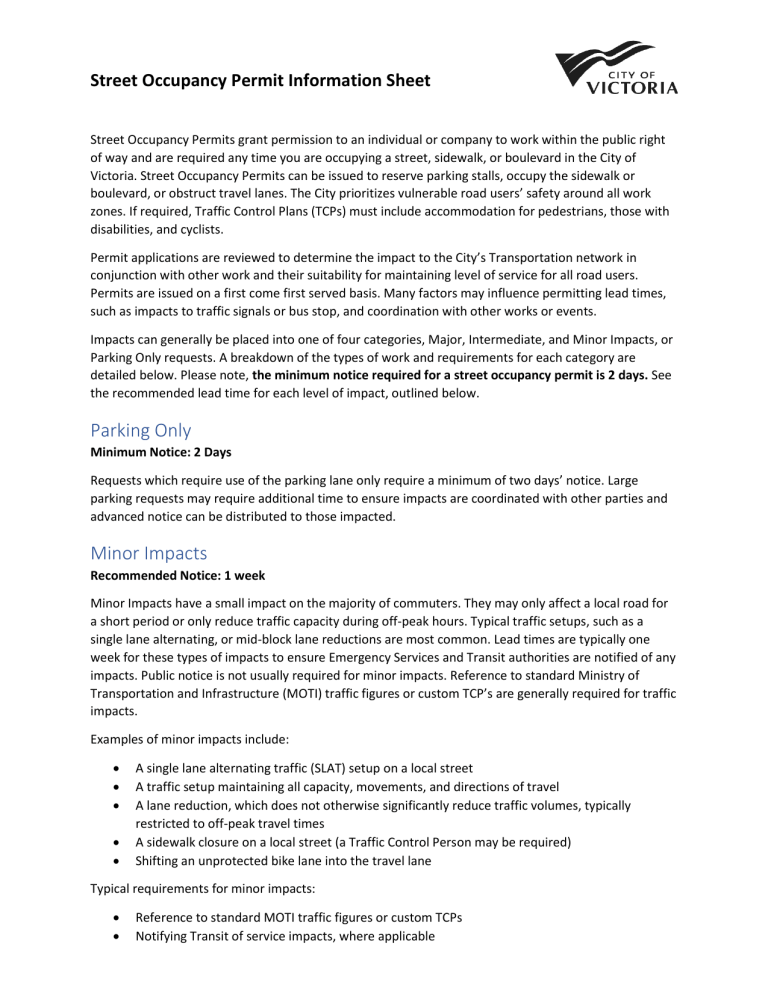22-07-27 CofVic Street Occupancy Permit Info Sheet
advertisement

Street Occupancy Permit Information Sheet Street Occupancy Permits grant permission to an individual or company to work within the public right of way and are required any time you are occupying a street, sidewalk, or boulevard in the City of Victoria. Street Occupancy Permits can be issued to reserve parking stalls, occupy the sidewalk or boulevard, or obstruct travel lanes. The City prioritizes vulnerable road users’ safety around all work zones. If required, Traffic Control Plans (TCPs) must include accommodation for pedestrians, those with disabilities, and cyclists. Permit applications are reviewed to determine the impact to the City’s Transportation network in conjunction with other work and their suitability for maintaining level of service for all road users. Permits are issued on a first come first served basis. Many factors may influence permitting lead times, such as impacts to traffic signals or bus stop, and coordination with other works or events. Impacts can generally be placed into one of four categories, Major, Intermediate, and Minor Impacts, or Parking Only requests. A breakdown of the types of work and requirements for each category are detailed below. Please note, the minimum notice required for a street occupancy permit is 2 days. See the recommended lead time for each level of impact, outlined below. Parking Only Minimum Notice: 2 Days Requests which require use of the parking lane only require a minimum of two days’ notice. Large parking requests may require additional time to ensure impacts are coordinated with other parties and advanced notice can be distributed to those impacted. Minor Impacts Recommended Notice: 1 week Minor Impacts have a small impact on the majority of commuters. They may only affect a local road for a short period or only reduce traffic capacity during off-peak hours. Typical traffic setups, such as a single lane alternating, or mid-block lane reductions are most common. Lead times are typically one week for these types of impacts to ensure Emergency Services and Transit authorities are notified of any impacts. Public notice is not usually required for minor impacts. Reference to standard Ministry of Transportation and Infrastructure (MOTI) traffic figures or custom TCP’s are generally required for traffic impacts. Examples of minor impacts include: • • • • • A single lane alternating traffic (SLAT) setup on a local street A traffic setup maintaining all capacity, movements, and directions of travel A lane reduction, which does not otherwise significantly reduce traffic volumes, typically restricted to off-peak travel times A sidewalk closure on a local street (a Traffic Control Person may be required) Shifting an unprotected bike lane into the travel lane Typical requirements for minor impacts: • • Reference to standard MOTI traffic figures or custom TCPs Notifying Transit of service impacts, where applicable Intermediate Impacts Recommended Notice: 2 weeks An Intermediate Impact generally has a significant impact to an arterial or collector street for a short duration or a mild impact for a longer duration. Typical permit lead times for intermediate impacts are two weeks, allowing time for proposal review and to provide advance notice to the public, Emergency Service providers, and Transit authorities. Examples of intermediate impacts include: • • • • A long-term capacity reduction on an arterial or collector street which does not push significant traffic volume to nearby streets A short-term capacity reduction on an arterial or collector street limited to off-peak travel times Long-term sidewalk, bike lane, or transit impact Long-term impacts to a local street Ways to mitigate intermediate impacts: • • Plan working hours during off-peak travel times Consider staging the work across multiple days Typical requirements for intermediate impacts: • • • A professionally made TCP outlining the area of work and all traffic control measures to be used, including signage. Advance notice to impacted users. Typically, in the form of distributed letter or notice boards. Transit planning including documented correspondence with BC Transit and bus stop and shelter relocation (if required). Major Impacts Recommended Notice: 2 months A major impact typically has significant or long-term impacts to traffic, cyclists and pedestrians and generally occurs on arterial or collector streets. Typical permit lead times for major impacts are one month or longer allowing time for a comprehensive review, for any changes to be made to the proposal, as well as advanced notice to the public, Emergency Service providers, and Transit authorities. When significant volumes of traffic are pushed onto nearby streets, detour routes may need to be established and reviewed. Examples of major impacts include: • • • • A significant capacity reduction on an arterial or collector roadway during peak travel times Closing one (or both) directions of travel on an arterial or collector roadway Closing a busy sidewalk without providing a reasonable detour Closing a protected bike lane for an extended period Ways to mitigate major impacts: • • Plan working hours during off-peak travel times Consider evening or weekend work Typical requirements for major impacts: • • • • A professionally made TCP outlining the area of work and all traffic control measures to be used, including signage. Proposals for complex, long-term, or significant impact setups may require that a Traffic Management Plan be produced as outlined in the MOTI Traffic Management Manual (Section 3). Advance written notice to impacted users. Dynamic Message Signs in advance of and throughout the setup. Transit planning including documented correspondence with BC Transit and bus stop and shelter relocation (if required). Costs Fees for Street Occupancy Permits are determined through a calculation for the area of sidewalk and/or roadway occupied and number of lane closures. If the permit requires parking to be reserved by City of Victoria crews a $40 fee will be applied. A parking space is equivalent to 13 m2. The fee schedule is as follows: Sidewalk: $10 per day for each 13 m2 or portion thereof Roadway: Metered Street - $20 per day for each 13 m2 or portion thereof Unmetered Street - $15 per day for each 13 m2 or portion thereof Lane Closure: $25 per day for each travel or bike lane closure The Street Occupancy Permit Program is operated under the City of Victoria Streets and Traffic Bylaw No. 09-079 (Section 106). [link to file]

